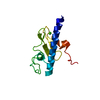+Search query
-Structure paper
| Title | Structure of the calcium-dependent type 2 secretion pseudopilus. |
|---|---|
| Journal, issue, pages | Nat Microbiol, Vol. 2, Issue 12, Page 1686-1695, Year 2017 |
| Publish date | Oct 9, 2017 |
 Authors Authors | Aracelys López-Castilla / Jenny-Lee Thomassin / Benjamin Bardiaux / Weili Zheng / Mangayarkarasi Nivaskumar / Xiong Yu / Michael Nilges / Edward H Egelman / Nadia Izadi-Pruneyre / Olivera Francetic /   |
| PubMed Abstract | Many Gram-negative bacteria use type 2 secretion systems (T2SSs) to secrete proteins involved in virulence and adaptation. Transport of folded proteins via T2SS nanomachines requires the assembly of ...Many Gram-negative bacteria use type 2 secretion systems (T2SSs) to secrete proteins involved in virulence and adaptation. Transport of folded proteins via T2SS nanomachines requires the assembly of inner membrane-anchored fibres called pseudopili. Although efficient pseudopilus assembly is essential for protein secretion, structure-based functional analyses are required to unravel the mechanistic link between these processes. Here, we report an atomic model for a T2SS pseudopilus from Klebsiella oxytoca, obtained by fitting the NMR structure of its calcium-bound subunit PulG into the ~5-Å-resolution cryo-electron microscopy reconstruction of assembled fibres. This structure reveals the comprehensive network of inter-subunit contacts and unexpected features, including a disordered central region of the PulG helical stem, and highly flexible C-terminal residues on the fibre surface. NMR, mutagenesis and functional analyses highlight the key role of calcium in PulG folding and stability. Fibre disassembly in the absence of calcium provides a basis for pseudopilus length control, essential for protein secretion, and supports the Archimedes screw model for the type 2 secretion mechanism. |
 External links External links |  Nat Microbiol / Nat Microbiol /  PubMed:28993624 / PubMed:28993624 /  PubMed Central PubMed Central |
| Methods | EM (helical sym.) / NMR (solution) |
| Resolution | 5.0 Å |
| Structure data |  PDB-5o2y: |
| Chemicals |  ChemComp-CA: |
| Source |
|
 Keywords Keywords | PROTEIN TRANSPORT / Klebsiella oxytoca T2SS / major pseudopilin / calcium / helical polymer / bacterial secretion / cryo-EM |
 Movie
Movie Controller
Controller Structure viewers
Structure viewers About Yorodumi Papers
About Yorodumi Papers





 klebsiella oxytoca (bacteria)
klebsiella oxytoca (bacteria)